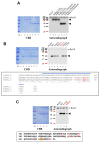Arabidopsis Raf-Like Kinase Raf10 Is a Regulatory Component of Core ABA Signaling
- PMID: 31480825
- PMCID: PMC6776158
- DOI: 10.14348/molcells.2019.0173
Arabidopsis Raf-Like Kinase Raf10 Is a Regulatory Component of Core ABA Signaling
Abstract
Abscisic acid (ABA) is a phytohormone essential for seed development and seedling growth under unfavorable environmental conditions. The signaling pathway leading to ABA response has been established, but relatively little is known about the functional regulation of the constituent signaling components. Here, we present several lines of evidence that Arabidopsis Raf-like kinase Raf10 modulates the core ABA signaling downstream of signal perception step. In particular, Raf10 phosphorylates subclass III SnRK2s (SnRK2.2, SnRK2.3, and SnRK2.6), which are key positive regulators, and our study focused on SnRK2.3 indicates that Raf10 enhances its kinase activity and may facilitate its release from negative regulators. Raf10 also phosphorylates transcription factors (ABI5, ABF2, and ABI3) critical for ABAregulted gene expression. Furthermore, Raf10 was found to be essential for the in vivo functions of SnRK2s and ABI5. Collectively, our data demonstrate that Raf10 is a novel regulatory component of core ABA signaling.
Keywords: ABI5; Raf10; SnRK2s; abscisic acid; phytohormone; signaling.
Conflict of interest statement
The authors have no potential conflicts of interest to disclose.
Figures







References
-
- Assmann S.M., Snyder J.A., Lee Y.R.J. ABA-deficient (aba1) and ABA-insensitive (abi1-1, abi2-1) mutants of Arabidopsis have a wild-type stomatal response to humidity. Plant Cell Environ. 2000;23:387–395. doi: 10.1046/j.1365-3040.2000.00551.x. - DOI
-
- Belin C., de Franco P.O., Bourbousse C., Chaignepain S., Schmitter J.M., Vavasseur A., Giraudat J., Barbier-Brygoo H., Thomine S. Identification of features regulating OST1 kinase activity and OST1 function in guard cells. Plant Physiol. 2006;141:1316–1327. doi: 10.1104/pp.106.079327. - DOI - PMC - PubMed
-
- Bensmihen S., Rippa S., Lambert G., Jublot D., Pautot V., Granier F., Giraudat J., Parcy F. The homologous ABI5 and EEL transcription factors function antagonistically to Fine-tune gene expression during late embryogenesis. Plant Cell. 2002;14:1391–1403. doi: 10.1105/tpc.000869. - DOI - PMC - PubMed
-
- Boudsocq M., Droillard M.J., Barbier-Brygoo H., Lauriere C. Different phosphorylation mechanisms are involved in the activation of sucrose non-fermenting 1 related protein kinases 2 by osmotic stresses and abscisic acid. Plant Mol Biol. 2007;63:491–503. doi: 10.1007/s11103-006-9103-1. - DOI - PubMed
MeSH terms
Substances
LinkOut - more resources
Full Text Sources
Molecular Biology Databases
Research Materials
Miscellaneous

